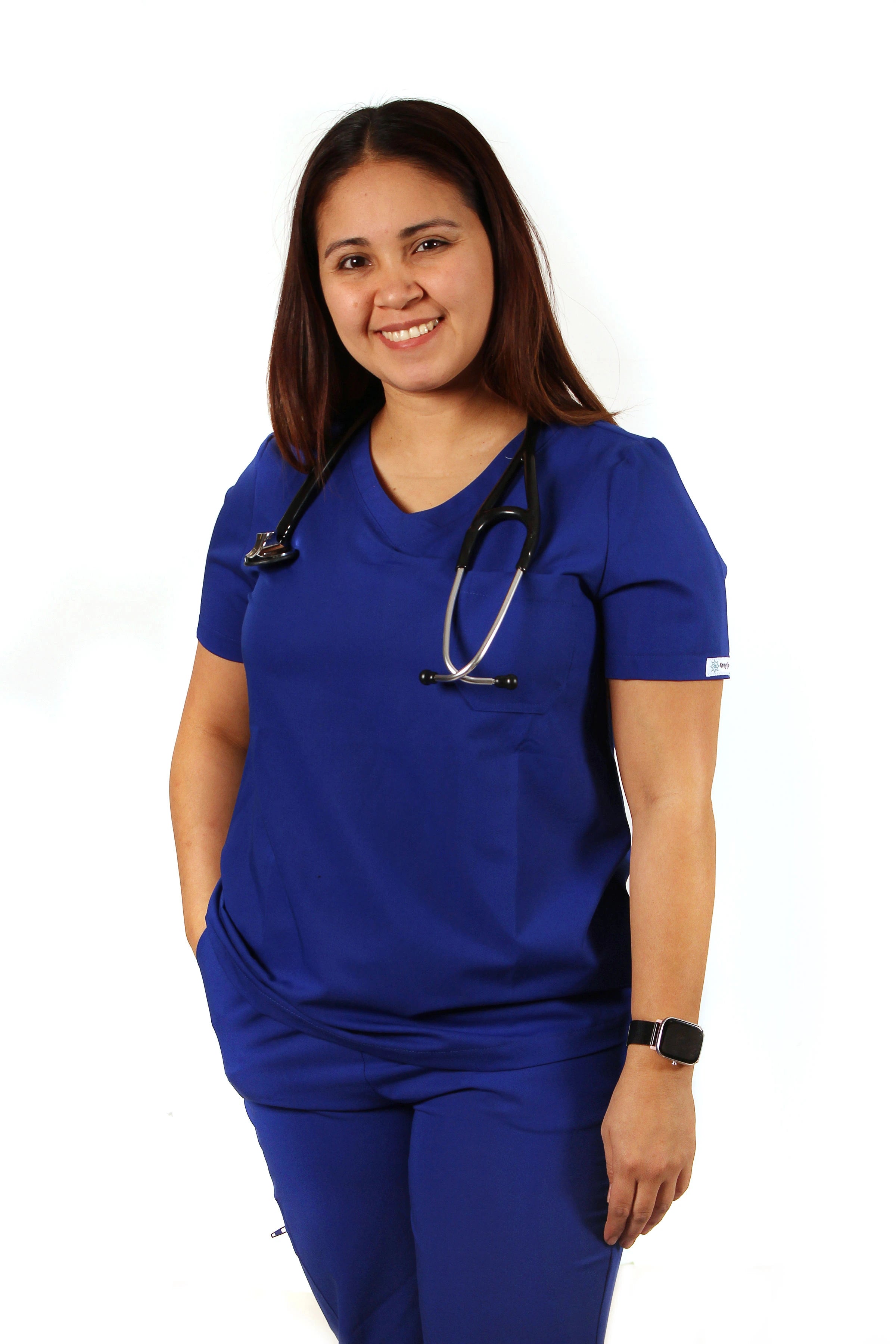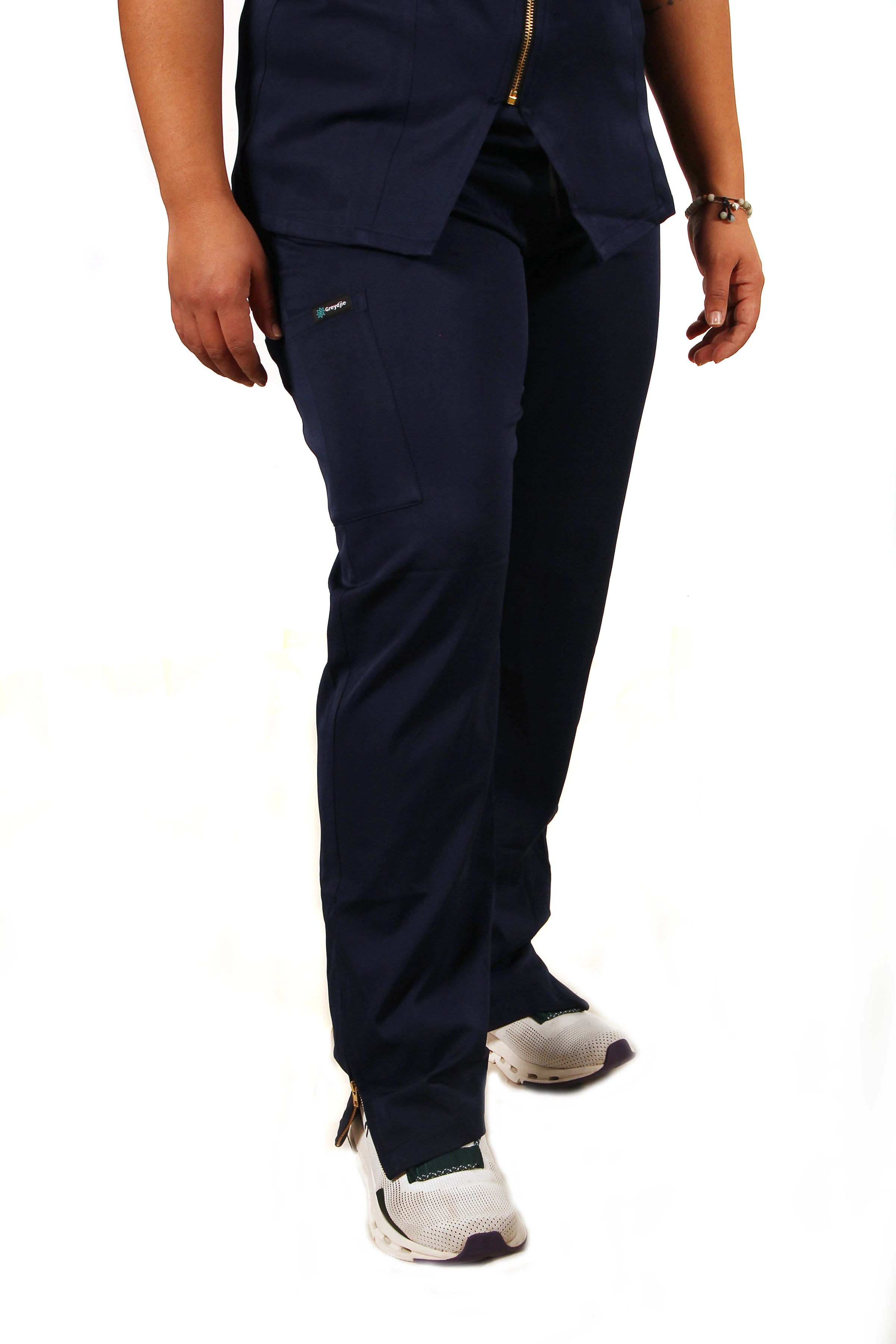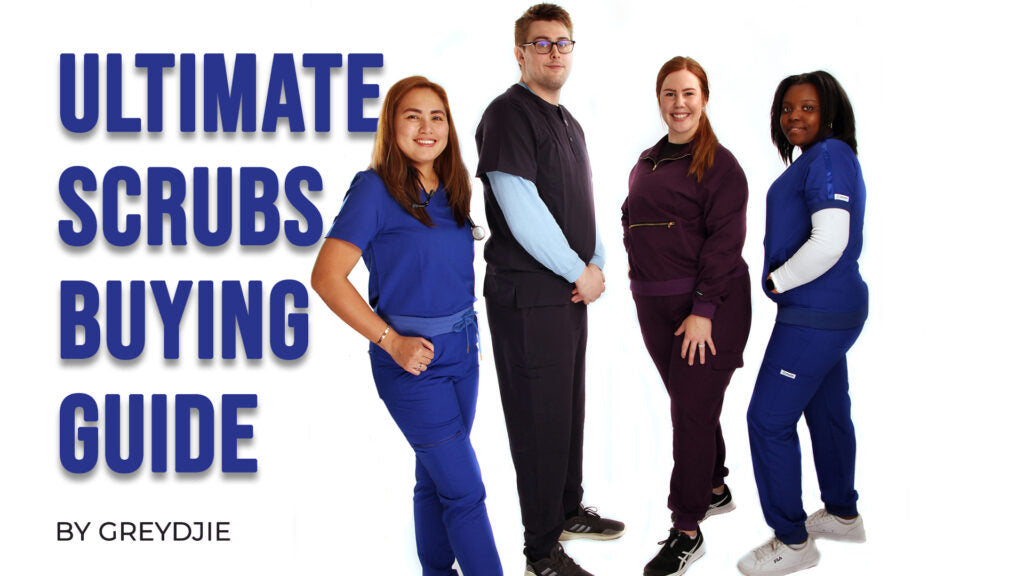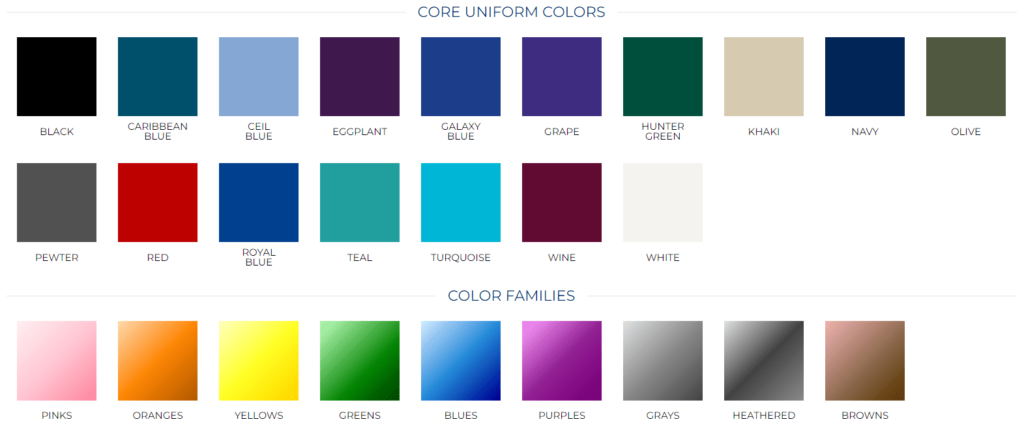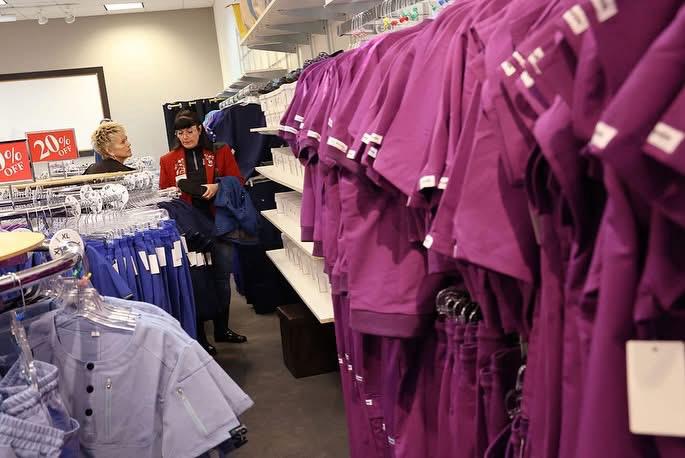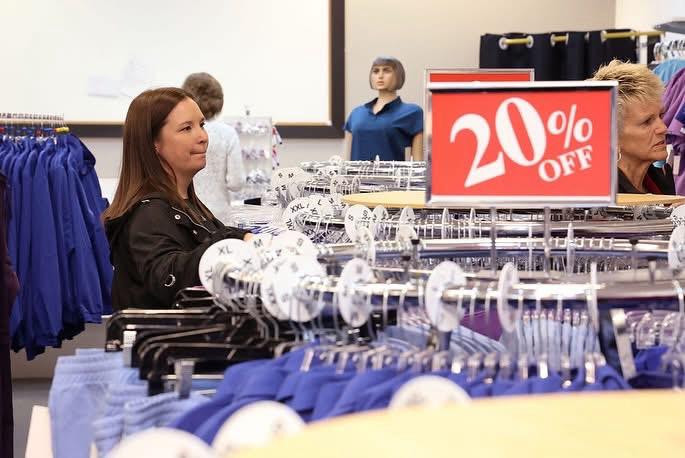Popular
Your Peace of Mind, Our Priority


Elevating Healthcare Attire Since 2012

What Our Customers Are Saying
Your Go-To Spot for Style and Scrub Tips
Scrubs Ultimate Guide
If you are new to Scrubs, it may seem like a minefield out there. Post-Covid a lot of you in the Medical, Care and Beauty industries who didn’t wear Scrubs before are now having to wear extra PPE to keep yourselves and your clients safe.
Whether you are new to buying Scrubs or you just need a refresh on what is available for yourself and your team, you may need some guidance on what is best for you, and what is available on the market.
Here at Work in Style, we have put together this Ultimate Scrubs Buying Guide. Taking you through all of your options, be that Style, Brand or material, we are here to help you make the best and most informed decision on your new Scrubs.
The main things you may want to take in to consideration when buying your Scrubs are;
- Fit
- Style
- Material
- Practicality
- Brand
- Personalisation
Below we will go in to detail on each of these points, but first let’s take a look at What Scrubs are and who wears them…
What are Scrubs ?
Scrubs are clothing designed to be worn in the Medical industry and more specifically by those providing patient care, they are easy to wear and easy to wash garments which are designed to create a barrier between the person wearing the Scrubs and any hazardous substances/chemicals which they may come in to contact with. This greatly reduces risk of contamination and risk of infections.
This type of clothing became known as Scrubs as they are used in a sterile (scrubbed) environment
Scrubs have been worn by Surgeons in America for many years but have only recently become popular in the UK in the past 10-20 years, replacing the classic Tunic style we may be used to seeing in hospitals and on our TV screens. Since the Covid 19 pandemic we are seeing more and more Healthcare professionals wearing Scrubs for daily use.
Scrubs are a great tool in large hospital settings to separate staff from patient or to identify team members, Scrub top and Scrub bottoms come in many brands, colours and sizes which can be mixed and match for your perfect set, or to differentiate between job roles and departments.
Who wears Scrubs?
The NHS have been using Scrubs for the longest time but are now being joined by an array of professions, Healthcare and more;
Nurses – Scrubs are great for Nurses as they provide comfort and ease of movement on their long demanding shifts
Doctors – Great for Surgeons especially as the Scrubs can be washed at high temperatures to further prevent any risk of infection or spread of contaminants
Vets – Lots of our Scrubs have fabric technologies such as soil release and anti-static which makes it super easy to wipe off hair, fluff and dust and guarantees you won’t end your day covered in animal hair (although we suspect that does kind of come with the territory)
Dentists – Dentists love our Scrubs! Especially the antimicrobial and fluid barrier properties which repel unwanted fluids which may come flying their way!
Care workers – Traditionally seen in Tunics, Care workers are now making the move to Scrubs after seeing a greater focus on infection control (Post Covid)
Midwives – I think it goes without saying that a Midwife will want some serious barrier protection between themselves and their patient and Scrubs are perfect for this
Beauticians – A new player on the block, since Covid-19 the Beauty and hair industries have begun to take extra precautions to protect themselves and their customers by investing in Scrubs for their teams
Alternative therapists – Think Sports therapists, Physios, Reiki masters and Acupuncturist, there are dozens of alternative therapists out there who now encourage wearing Scrubs for protection and comfort
Students – We supply scrubs to Nursing students all over the country who wear their very first set of Work in style Scrubs with pride

What to take in to consideration when buying your first or next set of Scrubs;
Fit – Scrubs are designed to be comfortable and free flowing to make your life and job easier
When choosing your Scrub set you want to look at the pictures and the product descriptions to ensure you are choosing the right fit for you, maybe you want a nice big free flowing top so you will go for a size up in a Unisex top. Want something more fitted? Then you may choose a ladies top with rib knit panels which are more fitted to the body to accentuate shape and look more fashionable and flattering
Whilst most of our Scrub trousers are straight leg, we also have jogger style trousers which are designed to be extra comfortable and wrinkle free for easy care
We have men’s, Ladies and Unisex Scrubs available. And remember that all of our Men’s styles can be used as Unisex – Make sure you use our size guides and you should get the perfect fit every time (and if you don’t we offer free returns on all UK mainland orders)
Style
Your usual Scrub set will consist of a V neck scrub top with short dolman sleeves and Straight leg scrub trousers with either an elasticated or drawstring waist, however this can vary when looking at the more premium Scrub styles. Here’s a few examples of different styles of Scrub Tops and Bottoms;
V Neck
Mock Wrap Top
Drawstring waist Trousers
Elasticated waist Trousers
Material
A very important factor in Scrub materials are the fabric technologies used, all aimed at keeping your scrubs clean, stain resistant and extra comfortable, for instance;
2 or 4 way stretch fabric – Stretch fabric achieved with small amounts of spandex in the fabric, the slight stretch gives your Scrubs the perfect amount of stretch for the perfect fit and added comfort
Anti-microbial – Providing long lasting freshness and protection against bacteria. Antimicrobial fabric technologies inhibit the growth of bacteria, algae and yeast, minimize odours and stains and therefore prolong the useful life of your Scrub set
Fluid barrier – The fluid barrier technologies are designed to resists spills for long lasting protection and make your clothing more breathable and durable, this feature is especially fantastic for Dentists and Vets due to the nature of their work
Anti-static – The anti-static technologies in our Scrubs is particularly useful for Vets as it allows fluff, dust and hair to release quickly from the surface of the fabric
Soil release – Soil release is achieved with a chemical finish that helps to easily remove dirt from the garment, while soil release will not prevent dirt from touching your scrubs, it will make it super easy to wipe and wash away with no special laundering needed.

Practicality (pockets, panels, technologies)
Whilst looking and feeling good in your Scrubs is great, the practicality of them is the most important factor, and Scrubs sure are practical!
You’ve already read about their many uses throughout an array of professions, Medical and not, you’ve read about their unique materials and fabric technologies which will keep you clean and safe at work, and you’ve read about the great range of fits, styles and sizes for all body types, but let’s delve a little deeper here in to the small details which make Scrubs the perfect choice for Healthcare professionals and more.
All of our Scrubs come with pockets, I doubt you have ever done a shift where you haven’t been over encumbered with utensils, don’t worry, Work in Style have your back, with chest pockets, pen slots and Patch pockets and media loops on our Scrub tops. Our Scrub trousers are bursting at the seams with pockets and storage options – Back pockets, front pockets, Cargo pockets, hidden zipper pockets, media loops and more. Check out the descriptions on our product pages to see exactly what pocket and storage options each Scrub Top and Bottoms have.
Many of our Scrubs have side vents and panels which create extra space and movement in your Scrub sets, this extra ease of movement is so valuable on long hectic shifts, the comfortableness of our Scrubs is one of their most important features!
Conclusion
Scrubs are the best choice for comfortable and practical healthcare, with their fabric technologies to keep you and your patients safe, plenty of colours and sizes to kit out your whole team, and a whole array of options to personalise your Scrubs. Order from our Scrubs range today, and don’t forget we offer free US delivery on orders over $100 and free returns for our US mainland customers
ORDER YOUR NEW FAVOURITE SCRUBS NOW
Diabetes can lead to many complications including eye disease, nerve damage, heart disease, and several other debilitating conditions. Managing your diabetes is one of the most critical steps in living a longer and healthier life as a diabetic. By following a strict plan you can cut your chances of getting diabetic related eye disease by 75%, cut your chances of getting kidney disease by 50%, cut your chance of getting nerve disease by 65% and lessen the likelihood that any complications you have already developed will get worse. Here are 7 steps that can dramatically increase your overall health while living with diabetes.
Controlling and Planning your diet
The most obvious first step to managing your diabetes starts with your diet. Eat a balanced diet on a regular schedule and decrease your portions. You should try and make half of your meal consist of fruits and vegetables, one quarter should be protein and the remaining quarter a whole grain. Most people know to limit sugar intake, but it’s also important for diabetics to monitor carbohydrates which can cause your blood glucose to spike. The recommended amount of carbs for women is 35-45 grams per meal and 45-60 grams per meal for men. Most people do not get enough fiber in general, and it’s very important for controlling blood sugar. Fiber helps clear cholesterol building in blood and slows digestion which helps us feel satiated without raising blood glucose levels.
A healthy diet has several benefits that you will enjoy unrelated to your diabetes, such as increased energy, improved memory and sleep patterns and an overall better health. It is recommended that a diabetic patient have a dietician on their medical team to specifically tailor dietary recommendations and planning to their needs. Diet is the foundation of a good diabetes management plan. For more information on eating healthy meals, visit Choose My Plate, a nutrition and meal planning website operated by the USDA

Current nutrition guidelines suggest 50% vegetables & fruits, 25% protein and 25% whole grain.
Regular Excercise
Doctors recommend that you get 150 minutes of light-moderate intensity exercise per week. That comes out to 30 minutes a day 5 days per week. Even though the recommended goals are practical, a recent study conducted by the CDC found that only 1 in 5 adults gets the recommended amount of aerobic and strength training exercise. Regular exercise directly lowers blood sugar levels, helps stabilize those levels, and is an important component of any weight loss plan (you can decrease your chances of getting diabetes, or getting further complications by reducing your weight by just 10 pounds). You do not have to get your exercise in a gym; walking, jogging, biking, aerobics and dancing are all good forms of aerobic exercise.
Adults that exercise regularly enjoy improved mood and energy levels. For more information on exercise recommendations, nutrition and healthy lifestyle you can check out the President’s Council on Fitness.

The American Heart Association Recommendations for exercise.
Regular Testing and Checkups
Your Doctor has likely set up a schedule for testing your blood glucose, but additional information will help your doctor construct your treatment plan and will also help you make better decisions about your healthcare. You should spot check your blood sugar levels in addition to regular testing. Check during breakfast one day, right after lunch one day, during a slow activity period in the evening the next day. This will give you a fuller picture of how your blood glucose levels are reacting to your daily routine, and also to any lifestyle changes you may be making. You should also get your A1C checked regularly to find out if your overall risk for complications is improving or getting worse. Weigh yourself every week and set up a schedule for checking your blood pressure. Check your feet and ankles for cuts, sores and blisters and keep track of how long it takes them to heal completely. Keep all of your data organized in a notebook or spreadsheet; it is useless to measure if you do not record. You should also schedule yearly checkups for:
- Urine protein test
- Cholesterol test
- Foot exam
- Dental exam
- Blood screening
- Dilated eye exam
By keeping track of these stats it will paint a picture of progress, decline or stability over time. You will get a better idea about which treatments and therapies that your body reacts positively to, and your doctor will have more accurate information to assess your health. If you are unsure about where to go for specific testing, you could check CDC’s Health Resources and Services Locator.
Educate Yourself
We know a whole lot more about Diabetes today than we did even 20 years ago. Diabetes is preventable if you know the causes and risks, and you follow a healthy action plan to avoid habits that increase your risk. We also know more about managing diabetes, and we learn more everyday. Read as much as you can on the subject and become familiar with risks, treatments, management strategies, definitions and studies. Knowledge is the road map that will help you navigate your lifestyle as a diabetic.
As you will learn, successful diabetic treatment requires a team of several medical professionals and specialists. The most important member of that team is you, and ultimately you are the person that will make decisions about your healthcare and you will be the person that either follows or ignores Doctor’s recommendations.
There are many resources for information about Diabetes.
Draft a Better Team
Diabetes is a complex, chronic, whole body disease. You need a primary care physician that is either an expert on diabetes, or willing to learn for your sake. If you aren’t confident that your doctor is taking your diabetes as seriously as you are, you should look into finding someone who will.
In addition to your primary care physician, it is highly recommended that a patient with diabetes have several specialists on their team that are all in communication with each other. All of the team members should have input on your healthcare plan, and any time that one of your doctors or nurses objects or has a concern with an aspect of your treatment, a conference with your whole team present should be called to decide on the best course of action. Having multiple doctors and specialists will ensure that you aren’t neglecting an aspect of your treatment, and that each person is held accountable, and doesn’t overlook anything. Your team will consist of several of the following:
- Doctor
- Dentist
- Diabetes Specialist
- Dietitian / Nutritionist
- Eye Doctor
- Foot Doctor
- Pharmacist
- Diabetes Educator
- Mental Health Counselor
- Nurse
- Friends and Family
- Other Specialists as Required
Improve Your Dental Health
Diabetes puts you at an increased risk of peridontal disease and tooth decay (diabetics are twice as likely to develop gum disease). Infection and gum disease in turn elevates glucose levels, and the same bacteria that causes gum disease causes heart disease, which is a complication of diabetes. This is a vicious cycle that can be easily controlled by brushing a flossing.
Most people do not realize the connection between diabetes and their dental health. Always tell your dentist that you are diabetic, he may put you on a more vigorous schedule for visits, and at the very least will be able to monitor symptoms that are more prevalent among diabetics. He may also recommend different products for diabetics (most dentists would recommend Listerine for patients with gingivitis, but the increased alcohol content can aggravate dry mouth symptoms).
Just treating gum disease will help control glucose 10%-20%. Scientists and healthcare professionals are finding more correlations between dental health and the rest of your body every day. Prevention is key; since dry mouth is one of the primary diabetic symptoms that lead to problems with dental hygiene, you can improve your dental health tremendously by controlling it.
- Avoid caffeine and alcohol
- Sip water throughout the day / Stay hydrated
- chew sugar free gum
- use an electric toothbrush
- use a saliva substitute
For more information about finding low cost dental care, visit the NIDCR Finding Dental care page.

Take Diabetes Seriously
29.1 Million Americans have diabetes, or 9.3% of the population. Diabetes is the 7th leading cause of death in the United States with 69,071 deaths listing diabetes as the underlying cause in 2010. 234,051 deaths listed diabetes as the underlying or a contributing cause. Still some diabetic patients never visit the doctor and make no changes to their lifestyle. The simple fact is that diabetes is a very serious and prevalent disease, and lots of people that have it do not treat it as such. There is a lot to do to manage diabetes; it’s not easy, but it is worth it. No one will take your diabetes seriously if you don’t take it seriously yourself.
As you pick out a medical uniform ahead of your next shift, it can be easy to grab the scrubs hanging in your closet or folded neatly in your dresser drawer without even considering the color. But what if we told you that nurse colors matter, not only to your peers but also to the patients you care for each day? While your workplace may require you to wear a certain color based on your specific job title, some employers in the healthcare field are more flexible than others. At Greydjie, we always want to help you look your best, so we’ve compiled a guide covering the most common uniform colors worn by doctors, nurses, surgeons, and medical assistants. We’ll also discuss each scrubs color meaning and why what you choose to wear to work matters more than you may have ever realized.
Nurse Colors and What They Mean
Whether you’re intending to portray authority to your fellow co-workers or cheer up your patients with bright scrubs, the color you wear to work can have a major impact on how others see you. From black to yellow and everything in between, learn about each scrubs color meaning and how to send the proper message to the people that matter most around you.
Black
A very bold and powerful color choice, the black scrubs meaning as seen above is consistent with strength, sophistication, and elegance. By wearing black scrubs, a feeling of formality is part of your presentation. Sporting black scrubs is a great way to earn respect from each medical professional and patient you interact with.
Blue
One of the most common nurse colors for the sense of calmness it creates, blue scrubs are peaceful yet distinctive. When you wear a blue uniform in a healthcare facility, there’s no question that you’re supposed to be there. Your patients will not only trust you, but also see you as a reliable caretaker.
Brown
Like khakis, considered to be both casual and professional, brown scrubs carry a similar connotation in the medical industry. As a color, brown is known to evoke a relaxing and genuine reaction, making it a quality choice for those who choose to wear it.
Green
Fresh and vibrant, the green scrubs meaning is focused on healing, well-being, and optimism, making it the perfect choice for those medical professionals whose patients could use a healthy boost. Wearing green scrubs not only encourages positive thoughts, it also provides people with a sense of reliability, durability, and safety.
Orange
If you think wearing green scrubs would make a statement, wait until you hear what we have to say about orange! Not only does it naturally make for the best Halloween scrubs in the fall, it’s also a color you can wear all year long to add energy and enthusiasm to the office. Orange scrubs symbolize cheerfulness and creativity, enhancing everybody’s mood in a welcoming way.
Pink
Feel pretty in pink, showing off your softer side with a favorite nurse color that exudes love. Wearing pink scrubs is a good way to show how much you care about what you do every day, with a nice reminder for your patients that nurturing is your top priority. Just as orange fits for Halloween, pink is a great choice for Valentine’s Day scrubs come February.
Purple
A color that stands for royalty and nobility, purple is a beautiful way to show off your power and elegance while still carrying yourself in a humble manner. Earn the admiration you deserve with purple scrubs, a signature look that radiates sophistication and an exceptional sense of style.
White
What sends a better message than a clean-cut look? Just as common as the color blue in the medical field, arguably even more widely worn, white scrubs are preferred by healthcare professionals at all levels. From lab coats to pants and more, white offers a fresh trend that continue to flourish and stand the test of time.
Wine
Depending on your taste, wine is a color that’s smooth and pairs together nicely with many other hues for a fashionable appearance. Just look at our scrubs color chart for proof! A shade of burgundy, wine scrubs are a classy choice for those days that you feel like dressing up a bit more. This professional color looks good, makes you feel good, and encourages others to do the same.
Yellow
Demand attention when you don yellow, applauded for its fun, bright, and energetic appeal. With yellow scrubs, you will surely bring happiness to the healthcare facility you work at. Like the summer sun, shine bright by showing your inviting personality. Simply put, you can’t help but smile when you’re wearing the color yellow!
Eggplant (Purple)
Wearing eggplant-colored scrubs signifies a sense of royalty and nobility. This rich hue exudes power and elegance while maintaining a humble demeanor. If you opt for eggplant scrubs, you radiate sophistication and a unique sense of style.
Royal Blue (Blue)
Royal blue scrubs evoke a feeling of calmness and reliability. They establish your presence in the healthcare setting, fostering trust among patients and colleagues alike. When you don royal blue scrubs, you are seen as a dependable caretaker.
Navy Blue (Blue)
Similar to royal blue, navy blue scrubs convey a sense of trustworthiness and professionalism. The deep, dark shade exudes authority and competence. Wearing navy blue scrubs commands respect from both medical professionals and patients.
Aqua Sky (Green/Blue)
Aqua sky-colored scrubs symbolize healing, well-being, and optimism. This vibrant hue is an excellent choice for healthcare professionals aiming to uplift their patients' spirits. It radiates positivity, reliability, durability, and safety.
Ceil Blue (Blue)
Ceil blue scrubs, with their tranquil shade, create a peaceful yet distinctive appearance. They leave no doubt that you belong in a healthcare setting, instilling trust and confidence in your patients. When you wear ceil blue scrubs, you are perceived as a reliable and caring healthcare provider.
Color-Coded Scrubs in Hospitals
While some healthcare facilities allow employees to wear the scrubs color of their choice, many hospitals implement a dress code policy to help patients easily identify what a medical professional’s everyday role is. The color could represent a caretaker’s exact job title or what department they’re part of, among other criteria depending on what hospital they work at. Most hospitals also include a scrubs color chart poster or printed brochure in each patient room, showing visitors what specific color each worker wears by discipline. Whether you’re a doctor, nurse, surgeon, or medical assistant, we’ll go over common color-coded scrubs in hospitals for each position below.
What Color Scrubs do Doctors Wear?
At medical institutions where a color code is enacted, doctors are known to wear medium-to-dark blue scrubs as they help them stand out among fellow healthcare professionals. And for this reason, both navy blue scrubs and royal blue scrubs are popular picks for doctors. They’re bold, authoritative colors that command attention. Depending on the hospital or facility you work at, there could be a different color used to represent doctors, however.
What Color Scrubs do Nurses Wear?
Traditionally, the most prevalent nurse color for professionals has always been white, mainly because it protrudes purity. White is not only consistent with cleanliness, but it also instills a feeling of order and authority. However, for workplaces that don’t require a color code, white can be seen as impractical for nurses because it’s a color that can show stains and be hard to clean.
What Color Scrubs do Surgeons Wear?
The color that’s most associated with surgeons is green, usually in a variation of teal scrubs or turquoise scrubs. Not only do these lighter shades look good with a variety of different skin tones, they’re also proven to be effective in covering up bodily fluids – an important consideration for surgeons.
What Color Scrubs do Medical Assistants Wear?
Considering the colors already discussed above for doctors, nurses, and surgeons, these medical professionals generally wear scrubs that differ from all the rest to show they’re an assistant. So, what color scrubs do CNAs wear? It depends on who and what department they work most closely with on a regular basis, and what scrubs they wear, but it’s safe to say any color that isn’t blue, white, or green. Whether it’s pink or purple, or even a neutral color like gray, black, or khaki, the most important factor to consider when deciding what color medical assistants should wear is contrast. If medical assistants look noticeably different from higher ranking positions, consider your color choice a successful one.
Now, armed with the knowledge of these scrub color meanings, you can make intentional choices that convey the message you desire to those around you. Whether you prefer the regal elegance of eggplant or the calming assurance of royal blue, your scrub color can speak volumes about your role in the healthcare field.
Vulnerable individuals such as children, the disabled, and the elderly are prone to be maltreated or abused. In the United States of America, the Center for Disease Control states that about 1 in 7 children and 1 in 10 adults over sixty years have experienced abuse. This data indicates that child or elder abuse is widespread, so it is necessary to curb it. A healthcare worker is legally and professionally responsible for reporting any suspected or actual cases of abuse to the local or state authorities.
In this article, you will learn more about mandated reporting and the specific role of healthcare workers as mandatory reporters.
What is Mandatory Reporting?
Mandatory reporting is a legal procedure that involves reporting confirmed or suspected cases of abuse and neglect. Professionals such as healthcare workers who tend children or elderly ones are expected to report abuse cases.
Apart from children and older people, adult females are at risk of physical or sexual abuse in their relationships. Besides physical abuse, healthcare workers should report financial, sexual, or emotional abuse. A few cases of abuse may be subtle, so health workers, especially nurses, can identify these signs from patients they encounter because of their nursing training.
Why is Mandatory Reporting Important?
Mandatory reporting plays a critical role in preventing abuse’s physical or psychological effects. Vulnerable individuals are at risk of developing preventable physical and psychological complications. Here are some of the impact of abuse.
Physical Effects
Elder and child abuse is associated with an increased risk of physical injuries such as bruises, cuts, and disabilities in the long term. Most children and older adults do not have the mental and physical strength to execute activities without assistance. For instance, cognitive disorders such as Parkinson’s disease may hinder self-care and personal hygiene practices in the elderly. These individuals are prone to falls and other preventable medical conditions such as fractures.
Psychological Impacts
Older persons and children are prone to emotional and psychological disorders when abused or neglected. A child exposed to physical violence at an early age may acquire a behavioral disorder. Anxiety with poor socio-emotional skills is common in children abused at an early age. Older adults may tilt to depression when no one can assist them with personal care.
Reduced quality of life
Children abused for a protracted period may develop post-traumatic stress disorder or develop behaviors such as substance abuse. This increases their risk of acquiring violent actions that affect their capability to learn and improve their skills.
Morbidity and Mortality
Rampant abuse cause injuries, if left untreated, could eventually lead to complications or death. Neglected older people with movement disorders may suffer repeated falls, becoming a complicated head injury. Similarly, sexually abused children are more susceptible to sexually transmitted diseases at an early age. Without early treatment, this might cause infertility in the future for these children.
Who Are Considered Mandatory Reporters?
Mandatory reporters are people who work with or take care of vulnerable populations. These professionals are often health workers and social workers, but teachers, police officers, and the clergy are regarded as mandatory reporters in some states. Among health workers, nurses are more exposed to children or older people. Therefore, they play a critical role in mandatory reporting in the health care sector.
What Types of Abuse are Nurses Mandated to Report?
Children and older adults experience different forms of abuse or maltreatment, and nurses are obligated to report cases to the local authorities immediately when abuse is suspected. Common causes of child abuse are abandonment, neglect, sexual exploitation, and trafficking. Elder abuse includes neglect, physical, financial, and sexual abuse.
What Are the Responsibilities of Mandated Reporters?
Health workers, especially nurses, are expected by law to identify the subtle signs of abuse or neglect among the vulnerable people they encounter in the hospital. Continuous education and mandatory reporter training provide health workers with the current information on mandatory reporting laws and regulations.
Ethical reporting empowers nurses to report suspected abuse cases for investigation. Nurses are protected by law when the investigated cases negate their suspicion. When you face a suspected abuse case, here are some steps to take before you carry out mandatory reporting:
- Clinical history taking: Take a brief history to clarify your suspicion. Ask open and close-ended questions to get specific answers from the client. For example, if you notice multiple bruises and cuts on a child, ask the child open questions to determine the cause of those minor injuries. When taking history, use a secluded environment where the guardian or parent will not influence the child’s response.
- Physical examination: Conduct a complete physical examination to detect the onset or presence of any morbidity. A holistic, systemic examination may reveal other signs of abuse a child may not discuss. For example, bruises and marked inflammatory changes in the genital area may suggest sexual abuse. This necessitates further laboratory examination for confirmation.
- Investigation: This step aims to confirm your clinical findings and rule out possible complications. For example, request a brain C.T scan to exclude any evidence of head injury if you noticed multiple scalp injuries or tears on the head of an elderly client.
- Report: Discuss and report your clinical findings with the hospital and local authorities. Submit a written report with details of your clinical results to substantiate your claims and help the investigators.
Final Thoughts on Mandatory Reporting
Health workers are responsible for the well-being of vulnerable people like children and adults. The mandatory reporting of any form of abuse promotes the health status of vulnerable individuals. As a mandatory reporter, carry out a thorough clinical examination and investigation of suspected cases. You should report both confirmed and suspected cases to the right authorities for investigation.


